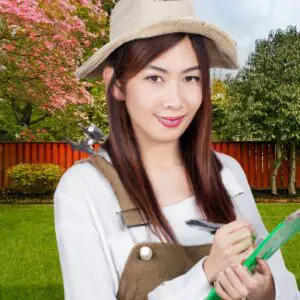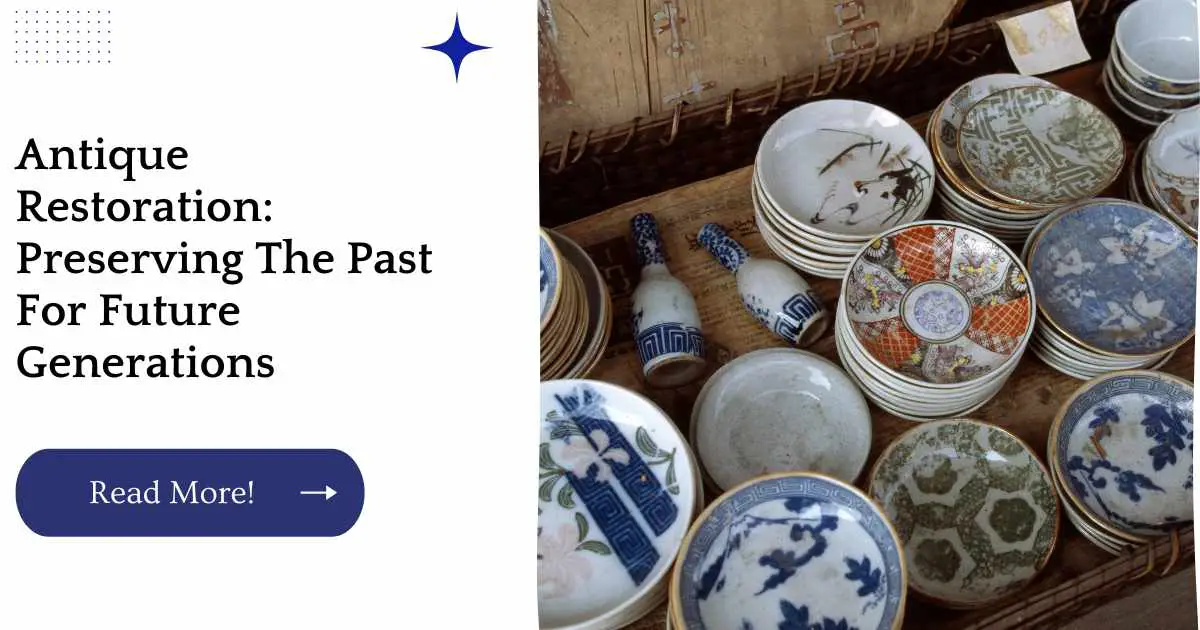If you’re an antique restoration expert, you know how important it is to maintain the original decor of your client’s homes and businesses.
But if you’ve never worked on an antique restoration project before, or even if you just want to make sure that your own family heirlooms remain in pristine condition for future generations, here are some useful tips that will help make sure your work is done right the first time:
| Takeaways |
|---|
| Antique restoration is an important process for preserving historical artifacts and cultural heritage. |
| Antique restoration involves specialized techniques and tools to repair damage and enhance the overall appearance of the antique. |
| Professional antique restorers have the experience and knowledge to properly restore an antique without causing damage or reducing its value. |
| To preserve antiques, it is important to handle them with care, avoid exposing them to extreme temperatures and humidity, and keep them out of direct sunlight. |
| Regular cleaning and dusting can also help prevent dirt and grime from building up on the surfaces of antiques. |
1. Keep Original Paint Colors
When restoring an antique, you’ll want to use as many of the original parts as possible. This includes using the same paint color that was on the piece when it was first made.
If you have a paint swatch from your original finish and color is important to you, then go ahead and use it!
However, if not, there are professionals that can help you decide which color(s) would work best with your antique furniture piece or table and they may even be able to match your current furniture’s finish exactly!
“The history of ancient artifacts, from the Pyramids to the Parthenon, provides a glimpse into the past and serves as a reminder of our rich cultural heritage. Explore more about the fascinating stories behind these artifacts in our article on the history of ancient artifacts.”
2. Protect Your Treasures From The Elements
To protect your precious antiques, you’ll want to do all you can to prevent them from becoming damaged by the elements. Fortunately, there are several ways that you can do this.
The first option is simply using a dehumidifier to remove moisture from the air. This will help keep mold and mildew at bay, which is especially important if you live in areas with high humidity or excessive rainfall.
It will also help prevent damage caused by condensation on windows during colder months when heating systems kick in and make indoor rooms too hot for sensitive antiques.
Another option would be using a humidifier alone or in combination with other methods (such as those described above).
Humidifiers add moisture back into dry air so that it’s easier for antique furniture pieces made with wood or other materials prone to cracking/splitting when exposed to excessive dryness over long periods of time (e.g., glass cabinets) while also helping prevent damage caused by water accumulation within wooden structures due to faulty roofing systems.
3. Maintain A Climate-Controlled Space
Now that you have your antique restoration project in progress, it’s important to keep a few things in mind. First and foremost: maintain a climate-controlled space. This means maintaining a constant temperature and humidity.
You should also take steps to prevent mold and mildew from forming; this can be done by using dehumidifiers or air conditioning units if necessary.
Finally, make sure that your antique restoration area has good ventilation so that condensation does not build up on the object being restored or its surrounding materials.
Maintaining these conditions will help ensure that the objects in question are properly preserved during the course of their restoration efforts and even longer thereafter!
“The fascinating world of ancient artifacts and their stories never fails to captivate us. Discover more about the value and significance of these artifacts in our article on the fascinating world of ancient artifacts, and learn how they connect us to our past.”
4. Be Prepared For The Unexpected
The old adage of “prepare for the worst and hope for the best” is especially relevant when working on an antique restoration project.
You never know what you might find after stripping down layers of paint or varnish, and many antique pieces are brittle or have been damaged at some point in their past.
If you’re going to take on this kind of project, prepare yourself mentally and financially for all outcomes.
If your budget’s tight, consider starting small with something smaller than a piece of furniture (like a small table) until you get the hang of things before jumping into more expensive work. Don’t forget about secondary costs like shipping charges if you will be sending items out for repair!
5. Purchase Prepping Materials And Tools In Advance Of Restoration
While you’re waiting for your project to begin, it’s important to ensure that you have all of the materials and tools necessary. There are a few things to consider when buying these supplies:
The type of project that you are tackling. If you’re working on something small, like refinishing furniture or repairing an antique vase, then buying prepping materials in bulk might be unnecessary.
But if you’re working on a larger-scale restoration project like restoring an entire house or building a new one from scratch, then purchasing more than what’s needed is wise.
The area where the restoration will take place. If there is already plenty of space available especially if other people will be helping with the project then buying large amounts of supplies may be unnecessary; however, if there isn’t enough room in which these can be stored safely and securely (such as under lock and key) then purchasing enough supplies should always be considered before beginning any work at all
“Antique finds have a rich history and a story to tell. Our article on the fascinating history behind your antique finds explores the value of antiques and how they connect us to the past, providing insights into the stories behind these finds.”
6. Have A System For Tracking Progress Of A Restoration Project
If you are working on an antique restoration project, be sure to have a system in place for tracking progress. There are many ways to do this, but here are some ideas:
Use a project management tool. For example, you could use Trello or Asana to create boards that represent each stage of the restoration process (e.g., “Research” and “Sanding”).
You can add cards representing individual steps of your task list (“Research how-to”, “Buy sandpaper”, etc.) as well as tasks related to specific projects or clients like “Complete client X’s refinishing job”.
The great thing about these tools is that they allow you track who is responsible for each card (or checkbox) and when it was completed.
Use a simple checklist/to-do list app like AnyList or the built-in Reminders app on your phone, which will allow you easily keep track of all those little things that need doing during any given day’s work!
“Antique hunting can be an exciting adventure, but it requires some skills and knowledge. Check out our article on 10 tips for finding hidden treasures on your antique hunting adventures to learn about the best practices, techniques, and tools for successful antique hunting.”
7. Use Diaries, Logbooks And Photographs To Document The Project Before It Starts And After It’s Complete
Documentation is important.
It’s best to take photos of the process before you start, and then again after you complete it. This way, if a client has any questions about their antique restoration project at a later date, they can look back on your documentation to see how their piece was restored and what condition it was in when they received it back from you.
A photo logbook is also helpful for keeping track of progress. For example: “Day 1: Removed dirt from surface with vacuum cleaner (see photo).”
You could also keep an extensive diary or notebook that records details about the restoration project such as how long it took; what materials were used; who helped out with each aspect of the job; where supplies were purchased and/or made; etc…
Conclusion
We hope this post has helped to give you some idea of how to approach antique restoration. It’s a process that requires careful planning, but with the right knowledge and tools, you can work with your antique treasures whether they are paintings, furniture pieces or family heirlooms to preserve them for future generations.
“Exploring the history behind ancient ruins in Egypt can be a thrilling and enlightening experience. Learn more about the rich cultural heritage of this ancient civilization in our article on exploring the history behind ancient ruins in Egypt, and discover how these ruins serve as a window into the past.”
Further Reading
For more information on antique restoration and preservation, check out these resources:
The Hartford Extra Mile: This article provides tips and insights on antique restoration and the tools and techniques used in the process.
Furniture Medic: This website offers professional antique furniture repair and restoration services, as well as information on how to care for and preserve antiques.
Ponce Inlet: This article discusses the importance of preserving historical artifacts and antiques for future generations, highlighting the efforts made by the Ponce Inlet Museum to protect and conserve these treasures.
FAQs
What is antique restoration?
Antique restoration is the process of repairing and restoring antique items to their original condition. This involves using specialized techniques and tools to repair damage, clean and polish surfaces, and enhance the overall appearance of the antique.
Why is antique restoration important?
Antique restoration is important because it helps preserve historical artifacts and cultural heritage. By restoring antiques to their original condition, we can better understand and appreciate the past, and pass on these treasures to future generations.
What are some common techniques used in antique restoration?
Common techniques used in antique restoration include cleaning, polishing, repair of cracks and chips, reupholstering, and refinishing. These techniques require specialized tools and knowledge to ensure that the antique is properly restored without causing damage or devaluing the piece.
Can anyone restore an antique?
While some minor repairs and restoration can be done by amateurs, it is generally recommended to seek the help of a professional antique restorer for more complex or valuable items. Professional restorers have the experience and knowledge to properly restore an antique without causing damage or reducing its value.
How can I preserve my antiques?
To preserve your antiques, it is important to handle them with care, avoid exposing them to extreme temperatures and humidity, and keep them out of direct sunlight. Regular cleaning and dusting can also help prevent dirt and grime from building up on the surfaces.

Hi there! My name is Hellen James, and I’m here to talk to you about treasure hunting. I’ve been a fan of treasure hunting ever since I was a kid, and if you’re a fan of treasure hunting or just like the idea of finding a long-lost fortune, then this blog is for you.

